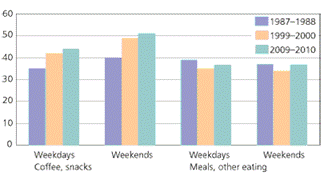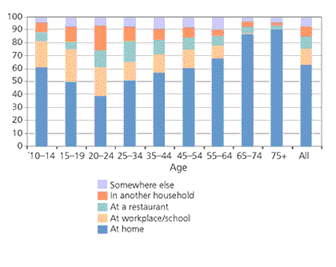Where and when do we eat?
- Time Use Survey data on eating out
- Looser patterns of mealtimes on weekends
- Eating alone and with others
- Occasions for eating out
- Less time spent at restaurants
- Income, age, attitudes and restaurant supply play a role in eating out
Koko dokumentti yhdell� sivulla
About the author: Johanna Varjonen is Senior Researcher at the National Consumer Research Centre. The article was published in Finnish in Hyvinvointikatsaus 3/2012 (Finnish title: Sy�misen ajat ja paikat).
The mainstay of our eating patterns has for many years been the meal that we take at home with our families. However, our eating habits have changed over three decades. The wide spread of microwave ovens in the 1980s made heating up food effortless and set family members free to eat at different times, and ready-made meals released families from the necessity of cooking. This made the most time-consuming domestic chore easier. The most recent change is associated with eating out, which frees us from the necessity of planning meals and buying ingredients.
PREVIOUSLY, eating out in our free time was something exceptional. We did it to celebrate a special day, or it was a special occasion in itself. It still is all of these things today, but eating out has also become part of every-day life for many. Even the term we use is a reflection of the way eating out has diversified: eating out has become a general term, instead of the more limited concept of eating at a restaurant.
In this article, I will have a look at where and when we eat, and examine changes that have taken place in our habits. I will focus particular attention to eating out in our free time.1 Looking back in history, it is notable that the time perspective of only two decades in this study is rather short for an activity that surely is as old as humankind.
However, never has there been a time in Finland when as much food was available, just waiting to be grabbed and stuck into your mouth, as there is now – if only you have the money to pay for it. In addition to restaurants and other actual eating places, caf�s and kiosks have sprung up on the kerbsides and in shopping centres where you can stop and have sweet and savoury pastries, beverages, sweets, snacks and, in summertime, fresh berries, or where you can buy these items to take away. We are tempted by the pleasures of eating much more often now than we did even a decade ago.
Eating out is understood as a wider concept than dining at a restaurant, as eating out also includes snacking. In our study, eating out was defined not only as dining at a restaurant or other eating place in the traditional way but also take-away meals and snacks which are prepared and sold by catering service companies but which you can eat at home or, literally, out. On the other hand, snacks and ready meals sold at supermarkets were excluded from the study. In conventional empirical data, including Statistics Finland's Household Budget Survey and the Study on the Trends of Dining at Restaurants commissioned by the Finnish Hospitality Association MaRa, little attention has been paid to increased snacking, even if coffee and buns and fast food have always been reported separately. Statistics Finland's Time Use Survey, similarly, distinguishes between meals on one hand and coffees and snacks on the other, and also reports where the respondents ate.
Initially, I will discuss some background information on eating out based on earlier research literature. Next I will look at analysis results related to eating in Statistics Finland's Time Use Survey data from different decades. I will then move on to examine the reasons for and practices of eating at restaurants based on data from the Study on the Trends of Dining at Restaurants2, and finally I will sum up the results produced by various sets of data.
Eating out has, in particular, been studied in countries where the restaurant industry is stronger than in Finland as a result of older urban settlement or tourism. Economic theory argues that cooking will be outsourced the more frequently, the higher the income of a household. The studies confirm this presumption at a general level, but the association is not quite as straightforward as that. The dissimilarities manifest themselves differently in visits to various types of restaurants.
Income seems to play a role in choosing an expensive and high-quality restaurant, whereas it does not seem to have a major effect on visits to fast-food places, pizzerias or ethnic restaurants. The studies also indicate that participation in working life, a reasonably large income and higher educational standard of the person responsible for providing meals in the family, as well as a high degree of urbanisation of the family's place of residence, increase the likelihood of eating out. Both parents taking part in working life and the ensuing shortage of time motivate families with young children to favour fast-food restaurants, as waiting for the dishes to be prepared at traditional eating places takes too long. (E.g. Byrne et al. 1998; Olsen et al. 2000; Lankinen 2008.) Finnish families with children often eat at fast-food restaurants when they are travelling, in which situation it is important that the meal is served without delay (the Promotion Programme for Finnish Food Culture Sre 2009).
In recent years, scientists have become interested in links between eating at restaurants and national health. This has been sparked by concerns over increasing obesity in young people. Fast-food restaurants in particular have been in the line of fire. While they are commonly seen as serving unhealthy food, irrefutable evidence of a connection between them and obesity has not been easy to prove, as weight management is also affected by many other aspects of our eating habits and lifestyle choices. Scientists standing up for fast food stress the fact that if you have had a heavy meal at a restaurant, you are unlikely to eat any more when you get home, as might be the case if you had only had a light meal (Mehta & Chang 2008; Anderson & Matsa 2011).
Unlike many Southern European countries, we have a strong tradition of communal eating in Finland, including free school lunches and subsidised meals at workplace restaurants. In such establishments, the planning of menus has for many years been governed by nutritional guidelines drawn up by experts, which is why communal meals have tended to promote healthy eating, including the use of vegetables and salads.
Time Use Survey data on eating out
The need for energy is a baseline that guides our meal patterns. Breakfast, lunch, afternoon coffee or some other snack in the afternoon, dinner and evening snack are the backbone of the ordinary eating pattern in Finland, in which individual variations occur. All or some meals can be taken at home or outside the home. Time Use Surveys help to trace an overall pattern of eating, and to variable degrees, also of eating out. What matters here is, of course, whether eating out has been distinguished from other meals in time use classifications. Time use classifications should be as similar as possible from period to period to allow us to observe the change in a certain activity.
Eating out has not been one of these activities, and our changing attitudes to eating at restaurants is clearly reflected in the classification of data from various decades. Eating out can be traced in two ways: on one hand, through the classification of activities in time use data and, on the other, classifications showing where the activity took place. In data from 1979, eating out was not separated from other eating. The material from 1987−1988 is excellent, as eating out has been distinguished in the data both in terms of its duration and the pattern of activities. The two latest Time Use Surveys note the duration of time spent eating out, but to discover the patterns, we have to rely on location codes.
In the following sections, I will first describe the time spent on eating as a whole, and then discuss how meals are distributed over the hours of the day. Figure 1 shows that eating is a vital daily activity in which differences are minor from year to year. A slight increase in the time spent on eating appears to almost exclusively be due to an increase in the time used to drink coffee and have snacks.
Figure 1. Time spent eating in 1987−1988, 1999−2000 and 2009−2010. Min/day.

Source: Statistics Finland. Time Use Survey
For the proportion of meals taken at home to those eaten out, see Figure 2. This Figure includes meals only, not snacks and the like. The group that eats outside the home the most frequently is those aged 20–24 years, who spend 60 per cent of the time they use for eating on having meals outside the home. Some 20 per cent of these meals are taken at a workplace or student restaurant, 20 per cent in another household and over 10 per cent at restaurants. The group that eats at restaurants most often, on the other hand, is those aged 25−34 years. There has been no change in this figure over the last twenty years. Eating at the workplace, on the other hand, has declined slightly in this age group. This may be the result of increased unemployment or having take-away meals at the workplace, as there has been no corresponding increase in eating at restaurants. We should note, however, that the Time Use Survey describes the time spent eating as an average per day, not as the number of meals had.
Figure 2. Where people have their meals by age group in 2009−2010. Share of all meals. Per cent.

Source: Statistics Finland. Time Use Survey.
The high incidence of having meals in another household, especially among those aged 20−24 years, is an interesting feature. It is as common as eating at a restaurant, school or the workplace, and has even become more common in this millennium. Eating in another household presumably means going to your parents' for a meal, and perhaps also groups of friends who enjoy cooking together as a pastime. Those in the retirement age tend to eat at home. This age group hardly ate out at all in 1987−1988, while eating out accounted for over 10 per cent of the time they spent on eating in 2009−2010. While the time spent on having meals at home has declined clearly, this reduction has not been fully compensated for by eating out, however. As a matter of fact, the explanation may be that meals have been replaced by snacks. The time spent having coffee and snacks increases from 43 minutes to 55 minutes a day when we move from the age group 45−54 to those aged 55−64 years. Presumably, the regular meals had by people in the working age are partly replaced by snacks in the age group 55−64. In groups older than this, the time spent having snacks increases further by a couple of minutes a day.
Alkuun Edellinen Seuraava
P�ivitetty 20.3.2013
